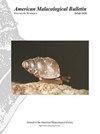Reproductive Cycle of Donax punctatostriatus (Hanley, 1843) (Bivalvia: Donacidae) in a Sandy Beach of Sinaloa, Mexico
IF 0.4
4区 生物学
Q4 MARINE & FRESHWATER BIOLOGY
引用次数: 3
Abstract
Abstract: The reproductive cycle, stages of gonadal development, and minimum size of sexual maturity are described for a population of the clam Donax punctatostriatus Hanley, 1843 from a sandy beach in southern Sinaloa, Mexico. A total of 880 clams were collected from January 2009 to June 2010; 3.2% were sexually undifferentiated and 1.4% had the trematode parasite Postmonorchis sp, in the gonadal tissue. The total length of the clams ranged from 3.5–25.64 mm ( = 13.51, S.D. = ±4.47 mm). The sexual proportion did not differ significantly from ♀1:1♂ (p > 0.05). The minimum size at sexual maturity (L50) was L50 = 12.03 mm. The gametogenic cycle comprise six stages of gonadal development (0-V). The population is reproductively active throughout the year and spawning is continuous, with three major peaks in April, July and September 2009. In March, when the water temperature was between 21–23 °C, most individuals were in stage I. This period is characterized by a rapid maturation of gametes. At the end of October and during November, when water temperature was warmer (25–28 °C), 50% of the individuals were in stage V (spent). Recruitment was more intense from July to October of 2009, when the highest temperatures of the year were recorded (28–31 °C). Photoperiod and the proportion of mature individuals of both sexes were significantly correlated (Pearson's correlation value = 0.62; p < 0.05). Since this clam is a potential resource for human consumption, the information here presented may contribute to a better management and use of their populations in the Mexican Pacific.墨西哥锡那罗亚Sandy Beach的斑纹唐纳的繁殖周期(Hanley,1843)(双壳目:唐纳科)
摘要:描述了1843年墨西哥锡那罗亚州南部沙滩上斑纹蛤种群的生殖周期、性腺发育阶段和性成熟的最小规模。2009年1月至2010年6月,共采集到880只蛤蜊;3.2%的性腺组织有性未分化,1.4%的性腺组织中有吸虫寄生虫Postmonochis sp。蛤蜊的总长度在3.5–25.64毫米之间(=13.51,S.D.=±4.47毫米)。性别比例与♀1:1♂ (p>0.05)。性成熟时的最小大小(L50)为L50=12.03mm。配子发生周期包括性腺发育的六个阶段(0-V)。种群全年繁殖活跃,产卵持续,2009年4月、7月和9月有三个主要高峰。3月,当水温在21-23°C之间时,大多数个体都处于I期。这一时期的特点是配子快速成熟。在10月底和11月,当水温升高(25–28°C)时,50%的个体处于第五阶段(耗尽)。2009年7月至10月的招聘更加激烈,当时记录了一年中的最高温度(28-31°C)。光周期和两性成熟个体的比例显著相关(Pearson相关值=0.62;p<0.05)。由于这种蛤蜊是人类消费的潜在资源,这里提供的信息可能有助于更好地管理和利用墨西哥太平洋地区的蛤蜊种群。
本文章由计算机程序翻译,如有差异,请以英文原文为准。
求助全文
约1分钟内获得全文
求助全文
来源期刊
CiteScore
1.00
自引率
40.00%
发文量
1
审稿时长
>12 weeks
期刊介绍:
The American Malacological Bulletin serves as an outlet for reporting notable contributions in malacological research. Manuscripts concerning any aspect of original, unpublished research,important short reports, and detailed reviews dealing with molluscs will be considered for publication. Recent issues have included AMS symposia, independent papers, research notes,and book reviews. All published research articles in this journal have undergone rigorous peer review, based on initial editor screening and anonymous reviewing by independent expertreferees. AMS symposium papers have undergone peer review by symposium organizer, symposium participants, and independent referees.

 求助内容:
求助内容: 应助结果提醒方式:
应助结果提醒方式:


